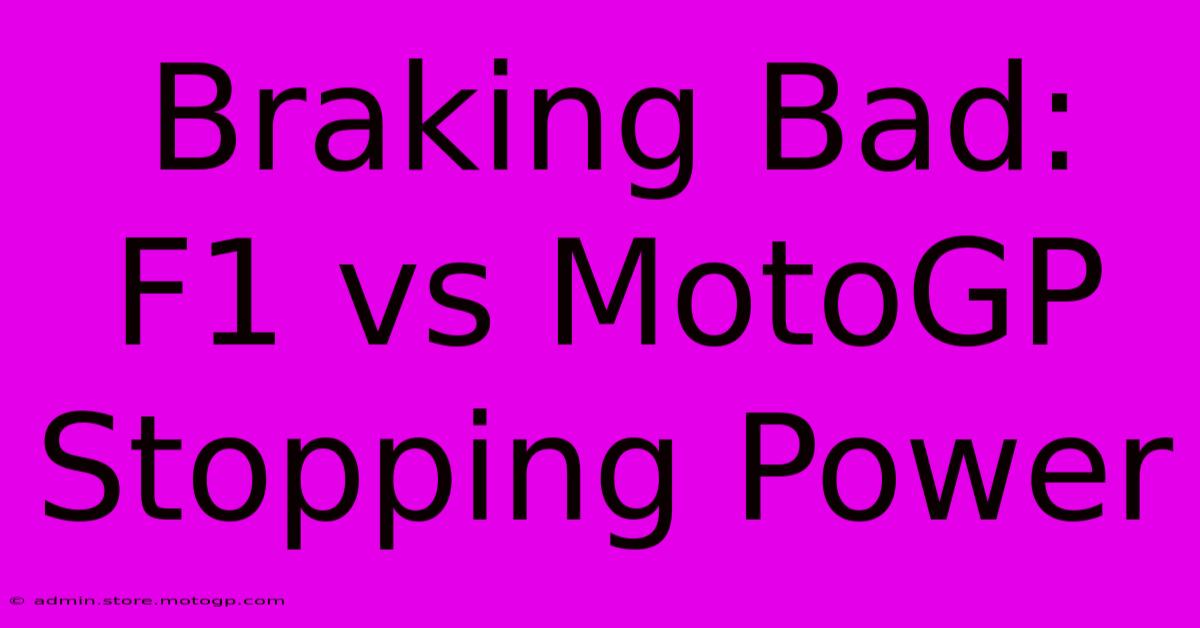Braking Bad: F1 Vs MotoGP Stopping Power

Table of Contents
Braking Bad: F1 vs MotoGP Stopping Power – A Head-to-Head Comparison
The roar of the engine, the smell of burning rubber, the sheer speed – Formula 1 and MotoGP are two of the most exhilarating motorsport spectacles on the planet. But beyond the raw power and breathtaking speeds lies a critical element that separates the champions from the also-rans: braking. This article delves deep into the fascinating world of stopping power, comparing and contrasting the braking systems of these two titans of motorsport.
The Physics of Fury: Understanding Braking Forces
Before we dive into the specifics of F1 and MotoGP braking, let's establish the fundamental physics at play. Both disciplines rely on kinetic energy conversion: transforming the vehicle's forward momentum into heat through friction. This friction is generated primarily by the brake pads clamping down on the rotors (discs). Several factors influence the effectiveness of this process:
-
Brake Disc Size and Material: Larger discs dissipate heat more efficiently, preventing brake fade (a reduction in braking performance due to overheating). The material composition – often carbon fiber composites in both F1 and MotoGP – significantly impacts heat resistance and braking power.
-
Caliper Design and Hydraulics: The calipers squeeze the pads onto the discs. Sophisticated hydraulic systems, precisely controlled by the rider/driver, ensure consistent and powerful braking.
-
Tire Grip: Even the best braking system is useless without adequate tire grip. The tires are the crucial link between the machine and the track surface, transferring the braking force to the ground.
Formula 1: The Apex of Braking Technology
F1 cars are renowned for their phenomenal stopping power. They utilize incredibly advanced systems, designed to withstand the extreme forces generated during braking from speeds exceeding 200 mph (320 km/h). Key features include:
Carbon Fiber Brakes: F1 cars employ massive carbon-ceramic brake discs, providing exceptional heat resistance and consistent performance lap after lap.
Sophisticated Hydraulic Systems: The braking system employs complex hydraulics with multiple pistons and finely tuned pressure control, ensuring precise modulation of braking force.
Aerodynamics Play a Role: The downforce generated by the F1 car's aerodynamics significantly increases tire grip, boosting braking efficiency.
ABS (Anti-lock Braking System): While not as prominent as in road cars, F1 cars use sophisticated ABS systems to prevent wheel lock-up under heavy braking, ensuring maximum control and stability.
MotoGP: Leaning into the Limit
MotoGP bikes present a unique braking challenge. The lighter weight and smaller contact patch of the tires compared to F1 cars mean different strategies are employed. Key aspects include:
Carbon Fiber Brakes – But Different: MotoGP bikes also utilize carbon fiber brakes, but their design is optimized for the lighter weight and different dynamic forces involved in cornering at extreme lean angles.
Leverage and Feel: The rider's feel for the front brake lever is paramount. Fine control is crucial for managing the bike's lean angle while braking aggressively into corners.
Engine Braking: MotoGP bikes often utilize engine braking, using the engine's resistance to slow the bike, reducing the burden on the brakes.
Tire Technology: The choice of tires and their grip level are crucial to MotoGP braking. Different compounds are used depending on track conditions and temperature.
The Ultimate Showdown: F1 vs. MotoGP
Directly comparing the braking performance of F1 cars and MotoGP bikes is difficult, due to differences in vehicle mass, tire contact patch, and overall dynamics. However, we can highlight key distinctions:
-
Stopping Distance: While F1 cars generally boast shorter stopping distances from higher speeds, this is partly due to higher downforce and larger tire contact patches.
-
G-Forces: Both disciplines generate incredibly high g-forces during braking, pushing the limits of both machine and rider/driver.
-
Control and Precision: MotoGP requires a higher level of precision and control from the rider, demanding delicate modulation of the brakes while maintaining lean angle.
Conclusion: A Masterclass in Braking
Both Formula 1 and MotoGP represent the pinnacle of motorsport braking technology. Each discipline faces unique challenges, requiring different approaches and technological solutions. The incredible stopping power on display in both showcases the relentless pursuit of performance and the mastery of engineering and skill. The next time you witness these incredible machines battling it out, take a moment to appreciate the phenomenal braking technology that allows them to push the limits of physics and human capability.

Thank you for visiting our website wich cover about Braking Bad: F1 Vs MotoGP Stopping Power. We hope the information provided has been useful to you. Feel free to contact us if you have any questions or need further assistance. See you next time and dont miss to bookmark.
Featured Posts
-
F1 Event Houston Tickets Selling Fast
Feb 17, 2025
-
Fuel Your Moto Gp Obsession Tnt Sports Schedule
Feb 17, 2025
-
Dont Miss Out Any Racing On Tv Today
Feb 17, 2025
-
Grand Prix Red Bull Experience The Intensity Of The Race
Feb 17, 2025
-
Bike Racing On Tv The Pinnacle Of Cycling Achievement
Feb 17, 2025
